In the year 2022, according to the SF procedural Soylent Green (1973), food shortages resulting from climate change will mean that half of the world’s population are reduced to eating mass-produced wafers that are made, it transpires, out of people. Which is to say, without wanting to tempt fate, that things could be worse.
Our own predictions for the coming year are less dire. A whip round at this morning’s editorial meeting raised hopes and expectations: the revival of performance; the imminent triumph of a new generation of Latinx artists; online art communities as havens against increasingly repressive regimes; the imminent triumph of a new generation of South East Asian artists; and so on. More broadly, there was hope that the crises of recent years might have conspired to force institutional reforms, tempered by the insistence that this will only happen if museums continue to be held to account by their audiences.
The emergence, or in some cases re-emergence, of alternative models for the exhibition of art was another popular theme. The future of NFTs and the establishment by major galleries of new platforms to showcase and sell them has been the subject of much speculation, countered by the hope that a generational shift in attitudes to work, time, and attention might be reflected in the operations of a more sustainable art world. These have already found one outlet in the much-vaunted rise of collectives and collaborative practices, with ruangrupa’s direction of the forthcoming edition of Documenta likely to test the limits of what an exhibition can be. Beyond this are the questions that have come to feel perennial: what does the future hold for art fairs? Can it bear any more figurative painting? Is the market sustainable? Is anything?
It is the responsibility of publications such as these, as our name exists to remind us, to set the agenda as well as respond to it. A regular new feature, undertaken in collaboration with writer and curator Filipa Ramos, will focus on the “ecological turn” in contemporary art, both in its conceptual applications (the cross-pollination of ideas from disciplines such as botany and zoology) and its practical applications (what do we mean by sustainable?). We’ll be commissioning essays investigating the new forms of thinking and writing about art that are being pioneered within the NFT community, rather than attempting to peg them to past examples from Warhol or Duchamp. And, of course, we’ll continue to publish writing that critically engages with the present in order, through the system of feedback that is art and criticism, to impact upon the future.
We’ve made a spreadsheet of the predictions made by editors at this morning’s meeting. It might be that at the end of the year we’ll publish it, and all the editors who got it wrong will be fired. Or it might be that the myriad ways in which we were wrong will simply serve to remind us that shifts in the culture cannot easily be extrapolated from the past. For all that, the most revealing aspect of this morning’s conversation was its tentative optimism, however much it was hedged by recognition of the difficulties facing artists and citizens around the world. Among his own reasons to be cheerful in spite of everything, Ian Dury included Bantu Stephen Biko, John Coltrane’s soprano, and “phoning up a buddy.” Fingers crossed that the new year adds a few more items to your list.
Each month, to accompany the editors’ letter, we publish a photograph from an artist’s place of work. This month we feature the London-based duo Revital Cohen and Tuur Van Balen, whose work investigates processes of production as cultural, personal, and political practices. Recent exhibitions include Serpentine Galleries, London (2021), 13th Shanghai Biennale (2021), Walker Art Center, Minneapolis (2020); current exhibitions include M+ Hong Kong; Palazzo delle Esposizioni, Rome; Kunsthal Charlottenborg, Copenhagen; Nottingham Contemporary; forthcoming at How Art Museum Shanghai and E-WERK Luckenwalde.

